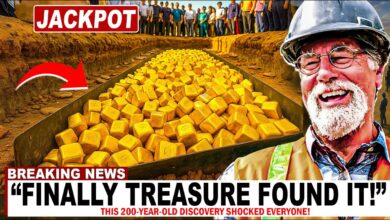The Curse of Oak Island: 5,000 Year-Old Tools Found on Lot 26 (Season 10)
The Curse of Oak Island: 5,000 Year-Old Tools Found on Lot 26 (Season 10)

GARY DRAYTON: I think we’re
going to be in for a great day.
PETER BRUNETTI: Yeah.
I’ll pull this first flag.
All right, mate.
NARRATOR: Less than 50
yards away, Gary joins Rick
and Marty’s nephew,
Peter Fornetti,
to search for clues in the
surrounding area that could
help explain just
who created the stone
well more than 800 years ago.
[beeping]
Oh, it sounds actually a
little bit better in there.
That’s the spot.
[intense music]
Hopefully, it’s
not surface junk.
[beeping]
Oh, it isn’t.
Look.
Look at that.
What is that?
More than likely, it
looks like a door holder.
PETER FORNETTI: Like, a hinge?
Yeah, like a hinge or
an hanger, a door hanger.
One end would have been
driven into the wooden frame
of a door, and then the door
would have been hung on this.
For a swinging door.
Been there a while
by the look of it.
It’s all encrusted.
PETER FORNETTI: Do you know
what era this is typical of?
GARY DRAYTON: I know
they go way back.
Something like that, is
that wrought iron or no?
Yeah, it’s probably
wrought iron and forged.
If it is wrought iron,
it’s pre-1830s or so.
Oh, yeah.
NARRATOR: Could
Gary and Peter have
found an ancient hand-forged
artifact on Lot 26?
One curious fact about this
four-acre property is that it
was once owned, from the late
1700s to the early 1800s,
by Samuel Ball–
a man who came to Oak Island
as a humble cabbage farmer
only to mysteriously become one
of the wealthiest landowners
in all of Nova Scotia.
We’re close to this well.
Yeah.
But we’re far away from
known establishments.
Yeah.
NARRATOR: Because the remains
of Samuel Ball’s 18th century
Homestead sits nearly 100 yards
northwest of this location–
GARY DRAYTON: Well,
mate, we’ll bag it ’cause
we know it’s potentially old.
That’s why we got
to dig everything.
Exactly.
NARRATOR: –is it possible
that Gary and Peter have found
evidence of a much older
structure that may be connected
to the mysterious stone well?
If so, might it also
be an important clue
that could help explain the
great fortune of Mr. Ball?
GARY DRAYTON: The next flag
is by another tree down there.
All right.
Let’s go to it.
All right.
Here’s the next one.
Yep.
[beeping]
Oh, I love that sound.
That’s a nice, sweet tone.
I know one thing.
This is super deep,
and we’re tagging it.
[intense music]
[beeping]
You’ve shaken it out,
mate, on that last lot.
Yep.
There it is, mate.
Oh, I know what this.
This looks like a pipe tamper.
Back in the day, people would
have had tobacco in the pipe.
And they would have used
this to pack it down.
This is nice, and the first
one we’ve found on Oak Island.
I love a first on Oak Island.
Yeah.
This does looked
like an oldie to me.
This looks like
it’s copper alloy.
It’s nice and crude.
Now, putting a date
on it is difficult.
PETER FORNETTI: This will be
an interesting one to throw
in the CT scanner to look for–
Yeah.
–some sort of
monogram or maker’s mark.
Yeah, because
some of them did.
They had the
initials or lettering
on there of the owner.
OK.
I know one thing, mate.
If it is a pipe tamper,
it’s a smoking find.
Let’s bag it.
GARY DRAYTON: All the artifacts
that we are recovering on Lot
26 are really important to me.
Because these artifacts will
tell the story, and hopefully
we can get to the bottom of
this little mystery on Lot 26.
And the next flag is over there.
OK.
[beeping]
I’m hoping these are good,
’cause we’re close to the well.
This the next one?
Yup.
[beeping]
Just there, mate.
[intense music]
[beeping]
That should be it.
[high-pitched squealing]
That’s singing, mate.
That’s a screamer of a
signal, right down the middle.
Right down the pike, mate.
Come on, artifact.
I think we’re about to save
a little bit of history.
[high-pitched squealing]
It’s here.
Oh, yeah?
Oh.
It’s like, a swing door
or a gate fastener.
It had some ring bolts on it,
and it just fit in the top.
This is the second
one of these objects
we have found in this area.
We find a lot of
one-offs on Oak Island.
Now we’ve got two very
similar iron artifacts.
They do seem out of place.
It’s not the type of area that
you expect to find artifacts
associated with doors.
We have to have
’em carbon dated.
So it’s a little bit of history.
And, hopefully, Carmen Legge–
PETER FORNETTI: Yeah.
–can shed some light on it.
All right, mate, keep moving.
The artifacts are
piling up on Lot 26.
[metal banging]
DOUG CROWELL: Hey, Carmen.
Well, hello.
You got some more
goodies this time?
You know we do.
NARRATOR: Oak Island historian
Doug Crowell and Scott Barlow
have traveled some 50
miles to Northville Farm
in Centerville, Nova Scotia.
They are meeting with
blacksmithing expert Carmen
Legge to get his professional
analysis of the metal artifacts
that were discovered two days
ago near the ancient stone
well.
So we brought a
couple of things
that Gary has found on Lot 26.
They were both found in close
proximity to each other.
We’ll let you have a look and
see what you think they may be.
All righty.
It has that
hinge appeal to it,
but kind of curious on
what you think they are.
Can I see the
other one too, Scott?
SCOTT BARLOW: Yup.
They both have a
similar shape to them.
Yeah.
This one is more encrusted,
and both the same thickness.
These are broken pieces
off of cutting tool.
These are from a bush scythe.
CARMEN LEGGE: Oh, wow.
NARRATOR: Dating back
as much as 5,000 years,
bush scythes were used
throughout Europe and Asia
as cutting tools in the
field of agriculture.
However, when
European cultures–
including the Spanish,
English, and Portuguese–
began exploring North
America by the 15th century,
bush scythes became essential
tools on large sailing vessels.
And a bush scythe
would be used to hack off
all the bushes and
small shrubs, anything
up to about an inch and a half.
And they would smash ’em off and
get encampment areas cleared so
that they could
come ashore, put up
a little habitation or something
like that sort of thing.
Yeah.
Actually, if you
look behind you there,
you’ll see a bush scythe leaning
up against the wall there.
You can bring that over,
and we can compare and show
you exactly what part this is.
Yeah.
This is what I remember,
except the ones
we had, they were much longer.
Yeah.
It’s a lawn blade
or a grass blade.
And if we compare
it with that one,
you can see it’s
the exact match.
Yeah.
That’s identical.
So if you were
going to put a date
range to these ones, what–
what would you think?
CARMEN LEGGE: These
are much older.
The way these are
made and shaped,
I’m gonna say
probably middle 1600s.
DOUG CROWELL: Wow.
NARRATOR: Bush scythes possibly
dating back more than 150 years
prior to the discovery
of the money pit in 1795?
Since no one is documented
to have settled on Oak Island
before the 1760s, who brought
these tools to Lot 26?
Could it have been
someone that was
looking for something of great
value in the 900-year-old stone
well?
Or was it someone who
actually repurposed it to hide
valuables there themselves?
The bush scythe dating
1600s, it’s interesting.
And then you transition
to Dr. Spooner’s work
indicating 1198 from the well.
How is that possible?
The only explanation
I have in my mind
is that the enormity of
the work done on Oak Island
was done in stages.
There was an infrastructure
stage, a depositional phase,
a implementation phase,
a logistics phase,
perhaps done over a
long period of time.
There are nuances to
telling the story,
and we need to make
certain that we’re
not misunderstanding any of it.
SCOTT BARLOW: And,
again, it reinforces
that people were probably
around here a little
before we thought they were.
CARMEN LEGGE: Oh, absolutely.
These are before any
settlement or habitation
here in Nova Scotia.
SCOTT BARLOW: Yeah
CARMEN LEGGE: Because it is
uncommon to see one this old.
Why would you need
a bush scythe on Oak
Island in that time period?
SCOTT BARLOW: And
to find two of them,
it almost suggests there may
have been multiple people
there trying to clear an area.
That could have
been very possible
that this was a point
of entry to the island,
where people were
coming ashore here.
You’ve got my
mind wandering now.
[laughter]
SCOTT BARLOW: We’ll let
you get back to work.
DOUG CROWELL: Thanks, Carmen.
CARMEN LEGGE: All right.
See you later.
SCOTT BARLOW: Thanks.








